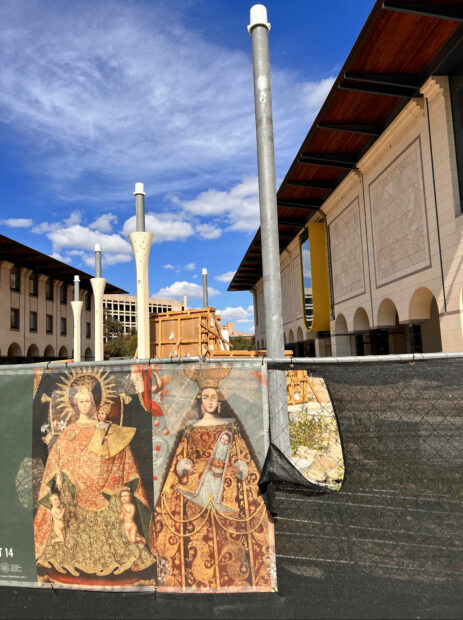How do you usually look at art? Do you read the label first? Stand close to see the details? Breeze through quickly? Take a tour? Do you look at it on an Instagram feed, in a gallery, or museum? Perhaps in your own home or at your local coffee shop?
I’d wager that most of us don’t usually look at works of art through a theater performance. In October of last year, visitors to Austin’s Blanton Museum of Art could watch a play by local theater company Salvage Vanguard Theatre (SVT) in conjunction with the special exhibition Painted Cloth: Fashion and Ritual in Colonial Latin America. Rather than interpret the works themselves, the play enlivened the imagined experience of a painter — a struggling artist commissioned to copy a series of portraits. Set in the round, performers moved in and out of tableaus on a square platform erected in the middle of the museum’s atrium. Stacked Waters by Teresita Fernandez, a permanent art installation on the walls, was the backdrop. Thomas Glassford’s Siphonophora, also a permanent installation, dangled above from the ceiling, gently swaying as the actors moved swiftly and displaced the air around the mobile sculpture. The space usually feels airy and expansive, but with the stage, seating, visitors, ongoing museum construction, theatrical accouterments, and audience seating, it was full.
When I arrived at the final dress rehearsal on October 30, I entered the museum through a side entrance — a door normally used by security staff and for emergency evacuations that serves as the temporary entrance during an ambitious grounds renovation. The facade of the building is covered with temporary plywood walls, and the museum lobby is unreachable. In a small breezeway, a makeshift reception desk and welcome sign greet guests. After walking through the typically invisible backside of the museum, I entered through a door at the back of the building, which is normally locked. The construction continued inside on the building itself, and in the atrium, too, as SVT crew members hurried to finish a wooden set for the play. They drilled and pounded hammers while docents floated by with tours, curious visitors lingered, and actors milled about doing vocal warmups and stretching.
While I waited I cruised through the exhibition, located in the adjacent special exhibitions galleries on the first floor of the museum. Painted Cloth has a lot of contextual information — labels with descriptions of various art forms, wall text contextualizing textiles, and literature that weaves together Spanish colonial influence and indigenous cultures. There is not much mention of casta paintings, the elusive focus of the original new play that is years-in-the-making by writer Adrienne Dawes, with the same name. Casta paintings are a type of portraiture from 18th century Mexico that depict the establishment of a racialized, hierarchical caste system during the colonial period. They are unique in their depictions of people of different racial identities in the same frame, and their labeling system, which can be seen in the upper right corner of the casta paintings on view in the exhibition.
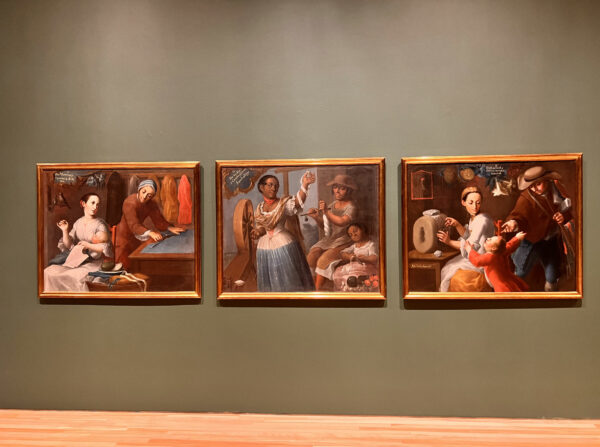
Installation view of three casta paintings in the exhibition “Painted Cloth,” on view at the Blanton Museum of Art. Photo by Christine Gwillim.
There are twelve casta paintings in the exhibition. One of the main works features three people, two with dark skin and one with lighter skin. To a modern eye, the casta paintings are not particularly striking in and of themselves. The genre in general, however, is important enough that curator Rosario Granados-Salinas eagerly agreed to collaborate on a play about casta paintings years ahead of the exhibition. In its examination of Casta portraiture, the performance draws a clear and moralizing correlation between art of the so-called Spanish Americas and the lasting harm of colonial occupation. The works in the exhibition subtly hover between cultures, sometimes with breathtaking results — such as textiles that incorporate local dyes, weaving techniques, and materials into depictions of European Catholic iconography. The stunningly intricate Mantle for a Statue of the Virgin Mary, attributed to an unknown Mexico City artist circa 1750, is an example of this cultural syncretism.
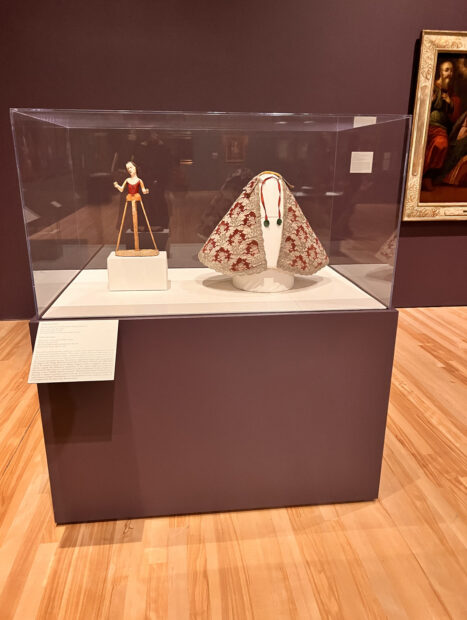
Installation view of works in “Painted Cloth,” on view at the Blanton Museum of Art. Photo by Christine Gwillim.
Casta, the performance, like the paintings that inspired it, wasn’t so pretty. All the props were made from soft felt, with care and virtuosity, but lacked the detailed realism of the paintings, or the intricate weaving of the exhibition’s textiles. Faceless puppets were masterfully maneuvered to depict children — alienating their humanity even further than the countless wall labels attributing works of art to “unknown” artists and artisans. Babies didn’t have faces, actors played multiple roles, the prop food was fake, and the protagonist struggled between his longing for accurate representation and the demands of the elite “Española,” Don Francisco, who commissions his work.
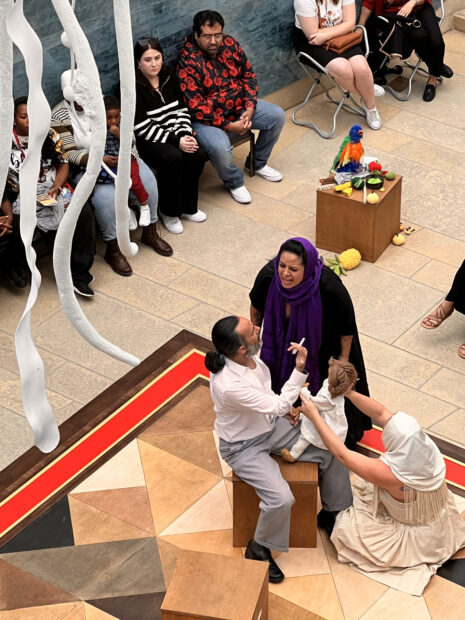
Actors in the play “Casta,” written by Adrienne Dawe and performed at the Blanton Museum of Art by Salvage Vanguard Theater. Photo by Christine Gwillim.
The play was broken down into sixteen tableaus, one for each casta portrait commission. Against his better judgment, our protagonist, played by Noel Gaulin, finds himself editing the portraits and changing their positions to show the peoples’ humanity rather than the idealized tableau requested by his patron. In so doing, he animates their stories and offers the audience a glimpse into what Dawes, the playwright, speculates were the actual lived conditions of dark-skinned people living in the so-called “Spanish America.”
The play covers a vast set of themes, from colorism, domestic violence, child abuse, transphobia, and classism to resilience and self-actualization. It is a dizzying and heartbreaking back-to-back portrayal of ordinary people trying to navigate the complexities of race as it was constructed in the region. Characters in the tableaus have essentializing names, such as “de Española” “Indio” “Meztizo” and “Negra,” a reference to the titles included in the upper left corner of each of the three casta paintings in the exhibition, which use the same labels to indicate the identity of each of their figures.
Though more specific than the countless works in the Blanton’s collection attributed to unknown artists, the play looks at the harm created by such labels and the absurdity of their formation. Actors from the cast code-switch with ease, adopting accents and mannerisms of various racialized categories, sometimes with humorously exaggerated results, as with khattieQ’s boisterous “el Macho” and Marina DeYoe-Pedraza’s flamboyant “de Española.”
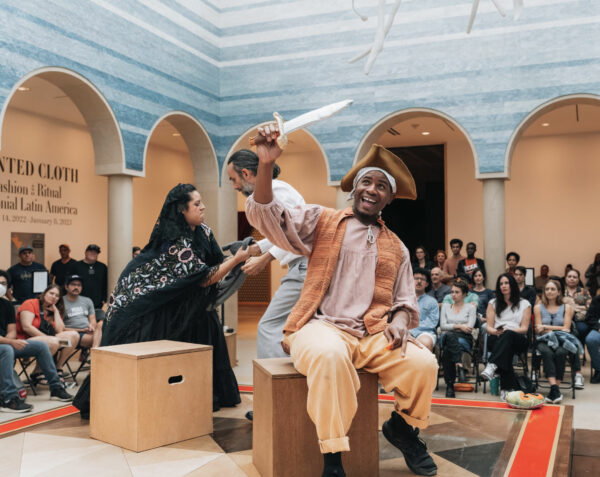
Actors in the play “Casta,” written by Adrienne Dawe and performed at the Blanton Museum of Art by Salvage Vanguard Theater. Photo by Amanda J. Steinbeck.
In the end, the painter fails his assignment. The audience is left to wonder about the sacrifices made by the artists who did complete the task, all whilst revealing that our protagonist is the painter Juan Diego, who also witnessed the apparition of the infamous Virgin de Guadalupe, and then created the celebrated masterpiece painting of his vision. It is both heartwarming and unsettling: it gives the painter an out from the world of derivative painting, but also indicates how deeply successful Spain was at converting indigenous people to Catholicism. Did he have the vision because he fought back against misrepresentation? Or was it because he assimilated enough to see divinity in the oppressors’ religious iconography? Perhaps the answer is woven together in the details of the works in the exhibition, which upon closer inspection, hint at each and every theme brought up in the play.
Walking the galleries after the show, one might look a little differently, wondering if the unattributed painters and craftspeople had agency in their creations, or if they were simply completing a commissioned job. Did they believe in the images they created? The play didn’t give us a clear answer, but it did offer a lens through which to examine historical art, and how to be both critical and celebratory at once. It also didn’t quite fit in the space; it was both approachable for many ages, and also impossible to ignore from within the galleries, as singing and resonant voices bounced off the museum’s limestone and acrylic walls. It was made to be dismantled; it wasn’t a masterpiece to be saved and traded and stored, and reexamined in hundreds of years. It was ephemeral, and for those of us that were there, it was never to be recreated in quite the same way.
In this way, it was made to shift our perspectives. If even for just a moment, it smacked us in the face with the discomfort of colonial collections — we could look away, but would still hear the dialogue throughout the exhibition. The performance was a refreshing change of pace for a museum that has attempted to shield visitors from potentially challenging content they might not want to see, such as when they built a complex corridor, viewing space, and signage through which to view Vincent Valdez’s controversial work The City in 2018.
Though not as overtly controversial, casta paintings are in many ways prequels to Valdez’s work — documenting early moments of soon-to-be systemic subjugation of Indigenous and African people in the Americas by European colonizers. SVT’s production offered a critical perspective on casta paintings and the harm they have caused, without need for a trigger warning or private viewing rooms. The exhibition doesn’t go so far — it lets us make our own conclusions, and without the play it would be easy to miss the subtle indicators that leap to life when taken off the wall and put onto a stage.
Bringing theater into the museum is an exciting way to reconsider how an institution might both care for visitors’ safety and capacity while also challenging them. Without Casta, many (dare I say most) of us who visited the exhibition would not have had such a rich context for how Painted Cloth and other exhibitions of historical works can help us make sense of how we got to where we are now.
Painted Cloth is on view through January 8, 2023 at the Blanton Museum of Art. Future plans for Adrienne Dawes’ Casta can be found at salvagevanguard.org
Correction January 9, 2023: This article has been updated to reflect that the exhibition included twelve casta paintings, rather than the three that were initially mentioned in this review.


